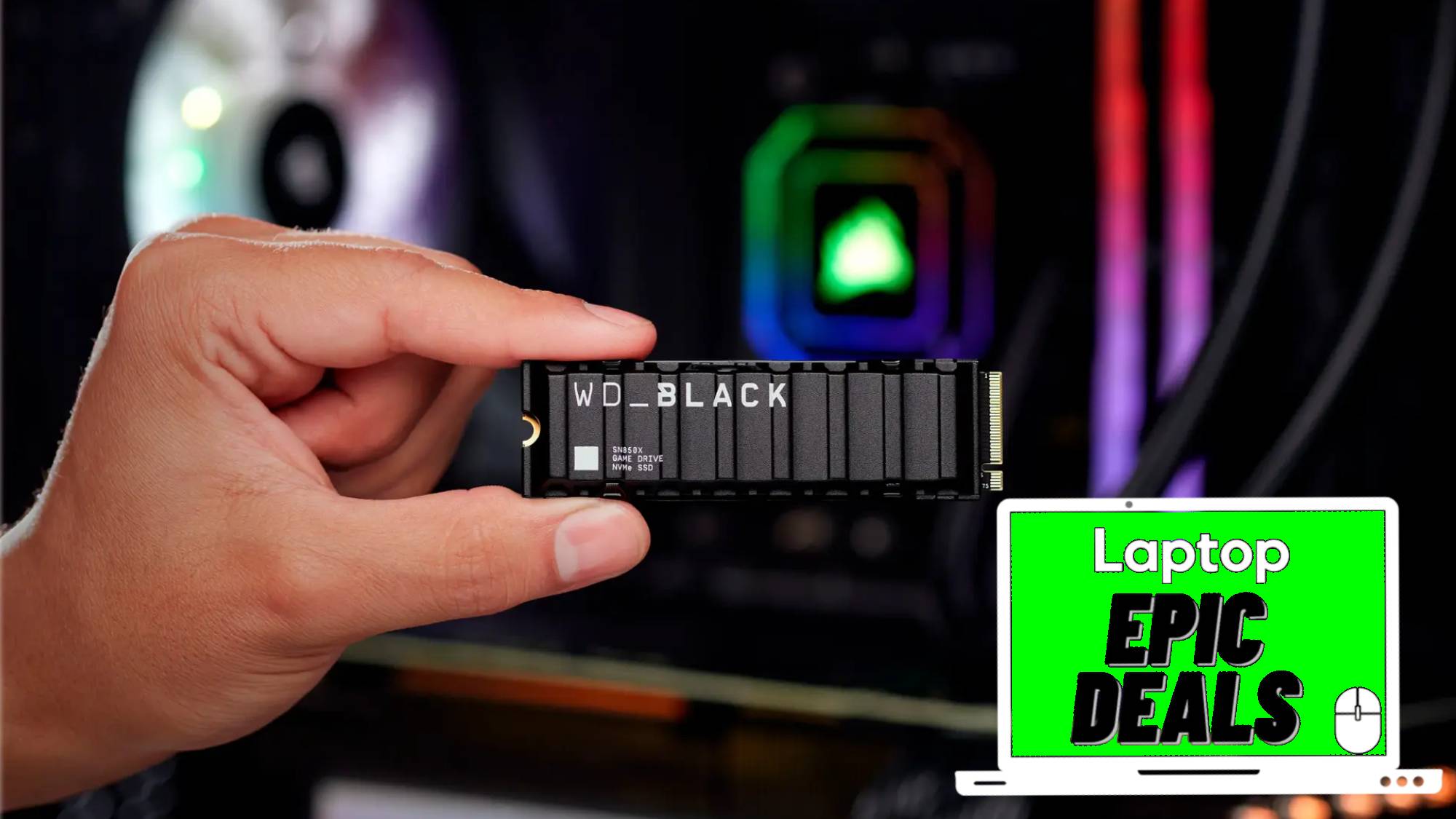Laptop Mag Verdict
Samsung's latest superphone boasts an ultra-slim design, a gorgeous screen, dual-core performance, and super-fast 4G speeds.
Pros
- +
Blazing performance
- +
Gorgeous screen
- +
Excellent 8-MP camera
- +
Fast 4G Data
- +
Long battery life
- +
Load speaker
Cons
- -
No HDMI port
Why you can trust Laptop Mag
If you think Samsung can't improve on the Galaxy S 4G--one of the best Android handsets to ever land on T-Mobile--you've got another thing coming. The company's new flagship smartphone, the $229 Galaxy S II, may put a big hole in the budget, but with a blazing 1.5-GHz dual-core Snapdragon S3 CPU, a brilliant 4.52-inch Super AMOLED Plus display--plus a powerful 8-megapixel camera--this phone sure is tempting. The Galaxy S II also surfs on T-Mobile's upgraded 4G network at a top-rated speed of 42 Mbps. Are you drooling yet? Find out if this ultra-svelte powerhouse is T-Mobile's greatest smartphone yet.
Design
Like many of today's latest smartphones, the Samsung Galaxy S II sports an all-black front face dominated by a huge touchscreen. The size of the display is even more impressive considering the phone's extremely thin profile (5.1 x 2.7 x 0.4 inches). The Galaxy S II's flat, slab-like shape has smoothly rounded edges which make for a comfortable grip.
Users with small hands, though, will find it difficult to reach the far side of the device. Despite being plastic, the phone's gray faux-metal styling creates a sophisticated look. Turning the Galaxy S II over reveals a textured black plastic cover that repels fingerprints. An 8-MP camera and LED flash is here too, along with a gently curved chin on the phone's bottom edge.
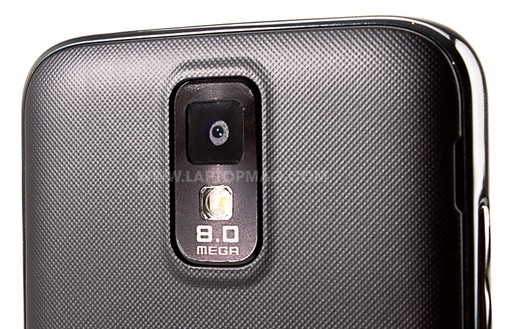
Click to enlarge
At just 4.8 ounces, the Galaxy S II is lighter than the HTC Amaze 4G (6.1 ounces) and the HTC Sensation 4G (5.2 ounces). Both the HTC Amaze 4G (0.5 inches) and the HTC Sensation 4G (0.4 inches) are thicker too, making them less pocket-friendly.
The top edge of the Galaxy S II has a 3.5mm headphone jack, the bottom has a microUSB port, a slim volume rocker sits on the left, and a tiny power lies on the right side. There's no HDMI port for outputting HD video to HDTVs, but Samsung sells an optional adapter ($39.99), which plugs into the microUSB port.
Display and Audio
From the moment you turn on the Galaxy S II, it's clear that you're in for treat. The handset's 4.5-inch Super AMOLED Plus display is bright and colorful, and it boasts very wide viewing angles. The screen's contrast is also high, and we were wowed by its deep blacks and sharp images, even in dark video content. When we watched Tron Legacy on Netflix, the endless blacks and pulsing neon colors of the Grid looked simply stunning.

Click to enlargeUnfortunately, the display's 800 x 400 resolution is not as high as those on the HTC Sensation 4G or the HTC Amaze 4G, which both use qHD (960 x 540) screens. Sprint and T-Mobile versions of the Galaxy S II feature the same large 4.5-inch display, but the AT&T model comes with a slightly smaller 4.3-inch Super AMOLED Plus screen.
The Galaxy S II's massive screen showcases web pages and videos without much need for zooming. However, Samsung provides a unique (but somewhat odd) custom gesture for enlarging content. Tapping and holding the phone at two points on the display and then tilting the handset even zooms in and out of web pages.
The sole speaker on the back of the phone gets surprisingly loud, especially for a device this thin. Still, music sounded one-dimensional, with little bass or sound separation to speak of. The dance track "Until We Bleed" by Kleerup was loud, with rich, life-like vocals but muted bass. Jazz standards, such as "So What" by Miles Davis, had more pleasing audio, with high-pitched horns and piano notes clearly reproduced at high volume.
Keyboard
The Galaxy S II's large screen provides a spacious area for typing on the virtual keyboard. The keyboard doesn't have dedicated buttons for .com or www., but you can access often-used symbols through a long press. The Galaxy S II also comes with the Swype keyboard that lets you form words by drawing lines to connect letters. With the device in portrait mode, we found drawing lines through letters slower but sometimes more convenient for when we were holding the device in one hand.
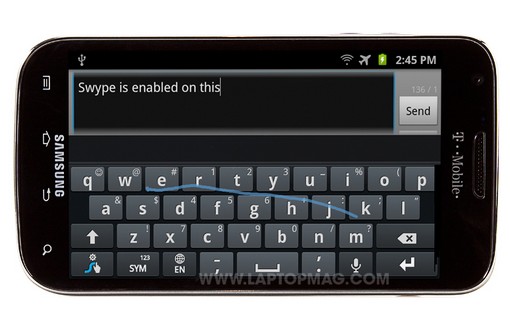
Click to enlarge
Software and Interface
Overlaid on top of Android 2.3.5 is Samsung's TouchWiz 4.0 interface, which makes few changes to Google's default UI. There are seven home screens to choose from, and all of them can be viewed at once by pinching the screen. The notification drawer contains a number of quick settings buttons for Wi-Fi, Bluetooth, and other connections. By default, the screens have useful widgets for quickly adjusting wallpaper and running applications.

Click to enlarge
Just like on other Android devices, users can add their own widgets and app shortcuts, but Samsung adds a deeper level of customization through its live panel widgets. The Picture Frame cycles through the images you select, while the AP Mobile and AccuWeather widgets display related info in real time. Plus, all the widgets can be resized to fit the available screen area.
Apps
Fun third-party apps include Netflix for streaming movies and TV shows, Slacker Internet radio, and the Asphalt 6 racing game. Watching movies over Netflix was enjoyable--with our entire queue at our fingertips--but in order to play Asphalt 6, we had to download a 455MB file, which took 35 minutes over Wi-Fi.
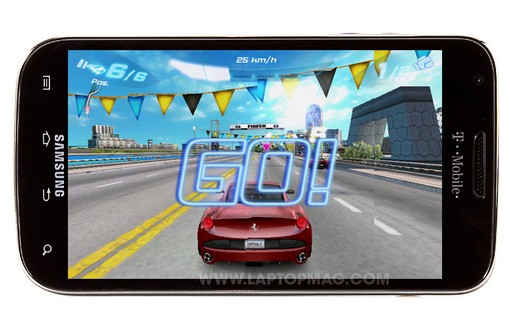
Click to enlarge
Samsung also bundles apps of its own, such as Media Hub (offering movies and music for purchase and download) and Social Hub, which pulls e-mail, Facebook, LinkedIn, and Twitter updates into a central location. The AllShare App streams media on the phone to a DLNA-enabled HDTV, provided it's connected to the same network. Similarly, Kies Air lets you access the phone's files from a networked PC.
T-Mobile also mixes in its own apps, such as T-Mobile TV, T-Mobile Name ID, and VIP Bonus Apps. Business-minded apps include Polaris Office for viewing business documents and a trial version of Lookout mobile security. In case you'd like to hide any of these apps, you can place shortcuts into folders on the home screen.
Performance
Unlike its AT&T- and Sprint-branded siblings which run 1.2-GHz Exynos C210 CPUs, the Galaxy S II on T-Mobile is powered by a 1.5-GHz dual-core Qualcomm Snapdragon S3 processor. On the CPU section of the Benchmark test it scored 3,365--enough to edge it past the Epic 4G Touch (3,165). The HTC Amaze 4G, which has the same 1.5-GHz Snapdragon processor, trailed behind both handsets with a score of 2,574.
On An3DBench, a test that measures 3D graphics performance, the Epic 4G Touch came back with a 7,937 result, which is high compared to the T-Mobile Galaxy S II's showing of 7,394. This score is more than 1,000 points higher than the smartphone category average and was enough to hold back the HTC Amaze 4G (7,253).
Real-world performance is where the rubber meets the road, and the Galaxy S II was agile and responsive whether we were zooming in and out of web pages, playing games, or streaming audio. The only hiccup we saw was the odd lurch opening an app when we had multiple programs running plus an animated live wallpaper active.
Web Browsing and 4G
The Samsung Galaxy S II is one of just two smartphones to access T-Mobile's upgraded 4G data network. Both it and the HTC Amaze 4G are rated at a theoretical top download speed of 22 Mbps, and T-Mobile estimates that users can expect average speeds of about 8 Mbps.
At an optimal T-Mobile location in a midtown deli, downloads averaged 16.2 Mbps and uploads at 1.7 Mbps, with max speeds of 17.8 Mbps down and 1.75 up. At a coffee bar near our Manhattan office, we measured slower--but still swift--speeds (12.6 Mbps down, 1.6 Mbps up). Even out in Queens, NY, we averaged a solid 11.7 Mbps up and 1.7 Mbps down. This even beats the HTC Amaze 4G speeds we saw in San Diego (15.2 Mbps down, 1.7 Mbps up). By contrast, Sprint's Epic 4G Touch delivered disappointingly slow throughput (4.4 Mbps down, 244 Kbps up). The HTC Sensation 4G, rated by T-Mobile at 14 Mbps (max), pulled down data at 4.3 Mbps and pushed it up at 1.8 Mbps.
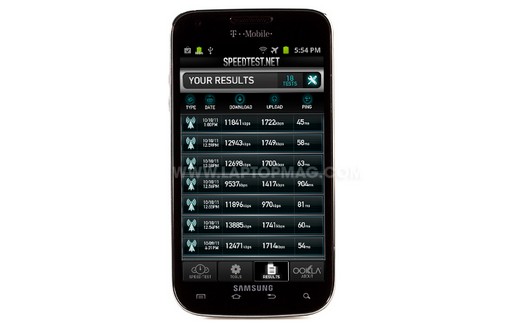
Click to enlarge
Likewise, site-loading times on the Galaxy S II followed a similar pattern. While the phone fired up mobile sites for ESPN.com and the NYTimes.com in about 6 seconds--the same as the Epic 4G Touch--loading the desktop version of Laptopmag.com took about half the time: just 11.5 seconds.
To share the Samsung Galaxy S II's swift network connection, the device can quickly kick into Mobile HotSpot mode, supporting up to eight devices for an extra $19.95 a month. A dedicated app just for this purpose sits on one of the phone's home screens.
Camera
Equipped with a powerful 8-MP main camera, the Samsung Galaxy S II provided a fun photo-taking experience. The phone cycles between shots in under a second, and its autofocus locked onto subjects with no perceptible lag. Daylight images of autumn tree leaves and bright blue skies had pleasing color. The sensor also did a good job at compensating between light and dark conditions, and when the flash needed to fire, subjects were evenly exposed. Though there are no fancy features such as the panorama mode found on the HTC Amaze 4G, we liked the anti-shake, auto contrast functions, and effects such as grayscale and Sepia.
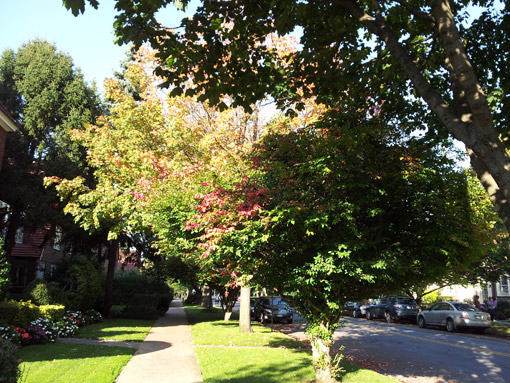
Click to enlarge

Click to enlarge
Video quality was also good, with footage taken at the camera's maximum resolution of 1080p on an NYC street corner showing sharp details of brick and concrete surfaces as well as the bright yellow of taxi cabs.
While the Samsung Galaxy S II has a 2-MP front-facing camera, the only pre-loaded video chat option is the Qik application. On our tests both on Wi-Fi and with a strong 4G signal, video chats were disappointing, with frozen frames, dropped calls, and blocky image quality. As an Android 2.3.5 device, the phone should theoretically be able to conduct video chat via Google Talk, but this ability was not listed. We downloaded the latest Skype app which now supports video calls, and image quality on calls over Wi-Fi was clear and audio easy to understand.
Call Quality
Calls made on the Samsung Galaxy S II were clear, and callers reported that our voice was easy to hear even on crowded city streets filled with traffic noise. Speakerphone performance was just as pleasant; people on the other end couldn't tell that we were using the phone hands-free.
Battery Life
Despite its super-thin profile, the Samsung Galaxy S II packs in a 1850 mAh battery that lasted a long 7 hours and 38 minutes on the LAPTOP Battery Test (web surfing over 4G). That's almost two hours longer than the current average for Android devices. It also outlasted the Epic 4G Touch (5:48, 1800 mAh), HTC Amaze 4G (5:40, 1730 mAh), HTC Sensation 4G (7:12, 1520 mAh), and myTouch 4G (6:09, 1520 mAh).
Verdict
Of the new crop of superphones on T-Mobile's network, the $229 Samsung Galaxy S II is the most compelling. Not only does it serve up bleeding-edge performance and feature a lovely Super AMOLED Plus display, it also offers incredible endurance. Another high-octane option on T-Mobile is the $259 HTC Amaze 4G, which features fast 4G, dual-core power, and an even better camera. However, many will fall in love with the Galaxy S II's slim size, eye-catching screen, and swift 4G speeds--and we can't blame them.
Samsung Galaxy S II (T-Mobile) Specs
| Audio formats supported | MP3 |
| Bluetooth Type | Bluetooth 3.0 |
| Brand | Samsung |
| CPU | 1.5-GHz Dual-Core Qualcomm Snapdragon S3 Processor |
| Camera Resolution | 8 MP |
| Carrier | T-Mobile |
| Company Website | www.samsung.com |
| Data | GPRS/EDGE/HSDPA/UMTS |
| Display (main) | 4.52-inch Super AMOLED Plus, 480 x 800 |
| Form Factor | Candybar Touchscreen |
| Front Camera Resolution | 2MP |
| GPS | Yes |
| Internal Memory | 16GB |
| Memory Expansion Type | microSD Card |
| Networks | Quad-band GSM world phone(850/900/1800/1900 MHz) |
| Operating System | Android 2.3.5 |
| Ports | microUSB, 3.5mm headphone |
| RAM | 1GB |
| Size | 5.1 x 2.7 x 0.37 inches |
| Video formats supported | MPEG-4, WMV |
| Weight | 4.77 ounces |
| Wi-Fi | 802.11 a/b/g/n |
